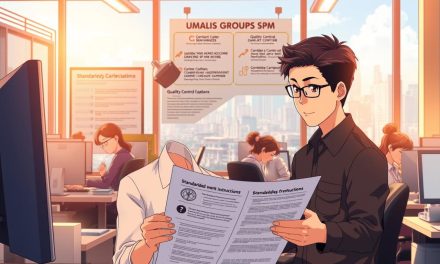What if the secret to a fulfilling career isn’t working harder, but working smarter? In today’s always-connected world, the line between our professional and personal lives has blurred. Many professionals feel the pressure to be constantly available.
Yet, recent research reveals a surprising truth. Despite rapid changes in how we work, job satisfaction remains high. This shows that a healthy work-life balance is achievable with the right strategies.
This guide provides practical steps to help you take control of your time. We understand that balance looks different for everyone. It’s not about perfect equilibrium every day, but creating a sustainable rhythm over time.
Our approach combines professional expertise with genuine care for your well-being. We’ll help you set boundaries and prioritize your health. The goal is to build a professional life that supports your overall quality of life.
Table of Contents
Key Takeaways
- Job satisfaction remains high even with modern work challenges.
- Effective strategies can help you achieve a healthy work-life balance.
- Balance is a sustainable rhythm, not daily perfection.
- Setting clear boundaries is essential for protecting personal time.
- Personalized approaches work best for individual needs and goals.
- Strategic rest is as important as hard work for long-term success.
Introduction: Navigating the New Work Reality
Today’s workplace bears little resemblance to the traditional offices of just a decade ago. Digital transformation has fundamentally altered how we approach our professional lives.
Defining the Modern Work Environment
The traditional nine-to-five model has evolved into flexible arrangements. Remote work and hybrid setups now dominate many industries.
Professionals face unique pressures from constant digital connectivity. The expectation of immediate responsiveness blurs boundaries between work and personal time.
The Need for Balance in a Digital Age
Maintaining healthy boundaries requires intentional strategies. The always-on culture demands new approaches to personal well-being.
Research shows that job satisfaction remains high with proper support systems. Workers need clear strategies for managing professional responsibilities alongside personal needs.
« The integration of technology has created both opportunities and challenges for today’s workforce. »
| Aspect | Traditional Work | Modern Work |
|---|---|---|
| Location | Fixed office | Anywhere with internet |
| Schedule | 9-to-5 rigid | Flexible hours |
| Communication | In-person meetings | Digital platforms |
| Work-Life Approach | Separation | Integration |
Finding your ideal professional rhythm requires understanding these shifts. Many people benefit from structured approaches to time management that acknowledge modern realities.
Understanding the Fundamentals of Work-Life Balance
Achieving harmony between career responsibilities and personal well-being represents one of modern professionals’ greatest challenges. This concept has evolved beyond simple time division into a more nuanced approach to life management.
What Work-Life Balance Means for Today’s Professionals
For contemporary workers, a healthy work-life balance means having flexibility to structure professional duties around personal priorities. It’s about creating sustainable rhythms that support both career growth and life satisfaction.
This approach recognizes that individual needs vary significantly. What constitutes good work-life balance differs based on life stage, family circumstances, and personal values.
Why Balance Is Vital for Mental and Physical Health
The impact on mental health cannot be overstated. Research shows workplace stress significantly contributes to anxiety and depression when professional demands overwhelm personal capacity.
Physical health suffers equally from imbalance. Chronic stress and excessive work hours correlate with serious conditions including cardiovascular issues and weakened immune function.
Conversely, proper equilibrium enhances professional performance. Employees with better balance demonstrate higher productivity and engagement. Understanding these fundamental connections helps create sustainable career success.
Developing Effective Time Management Strategies
The key to accomplishing more in less time lies in strategic planning of your daily activities. We help you develop approaches that maximize your productive hours while preserving energy for personal priorities.
Planning Your Day with Purpose
Start by assessing how you currently spend your work hours. Identify which tasks truly advance your goals versus those that drain your time. This honest evaluation forms the foundation for meaningful change.
Schedule both professional responsibilities and personal activities with equal importance. The Pomodoro Technique—25-minute focused intervals with short breaks—helps maintain concentration throughout demanding days.
Grouping Tasks and Setting Time Blocks
Group similar tasks together to reduce mental switching costs. This approach boosts productivity by allowing deeper focus on related work. You’ll complete more in fewer hours.
Align your schedule with natural energy patterns. Reserve peak mental clarity for demanding cognitive work. Use lower-energy periods for routine tasks. This strategic alignment makes your days more manageable and effective.
Creating Clear Boundaries Between Work and Personal Life
Creating definitive limits between work responsibilities and personal life requires intentional strategies and consistent application. We help you establish these essential boundaries that protect your well-being and enhance professional performance.
Establishing Digital and Physical Disconnects
Physical separation becomes crucial when working from home. Designate a specific workspace that you can physically leave at day’s end. This creates psychological distance between professional and personal modes.
Digital boundaries reinforce your physical limits. Consider separate devices or accounts for work and personal use. Apps that block work tools outside designated hours provide technological support for your boundaries.
Setting Non-Negotiable Work Hours
Define specific work hours that clearly mark your professional availability. These non-negotiable time blocks prevent work from expanding into all available hours. Research shows many workers log on outside standard hours due to pressure rather than necessity.
Communicate your boundaries clearly to colleagues and supervisors. Consistent communication ensures others understand your availability and response times. Start with small, manageable boundaries and gradually expand them as habits form.
Incorporating Mindfulness and Self-Care into Daily Routines
The connection between mental clarity and professional effectiveness begins with intentional mindfulness practices. These techniques help you recognize early signs of imbalance before they escalate.
Practical Techniques for Mindfulness
Simple practices like focused breathing and brief meditation sessions significantly enhance your ability to detect stress signals. Regular mindfulness builds greater attunement to your body’s needs.
Even short sessions provide measurable benefits for your mental health. These practices help you notice tension, irritability, or fatigue before they become serious concerns.
| Mindfulness Practice | Time Commitment | Primary Benefit |
|---|---|---|
| Focused Breathing | 2-5 minutes | Immediate stress reduction |
| Mindful Walking | 10-15 minutes | Mental refreshment |
| Brief Meditation | 5-10 minutes | Enhanced focus |
| Body Scan | 5-7 minutes | Tension awareness |
Strategies to Prevent Burnout
Taking regular breaks throughout your workday is essential for maintaining energy and preventing burnout. Research shows that even brief pauses boost productivity and focus.
« Working adults should take a break at least every 1-2 hours to maintain optimal performance. »
Commit fully to your time off by disconnecting completely from work communications. This approach protects your health and ensures genuine recovery from daily demands.
Building sustainable self-care habits starts with small, consistent practices that gradually become integrated into your routine. This investment in your well-being enhances rather than detracts from your professional effectiveness.
Tailoring Your Approach for Remote and Hybrid Work
Navigating the remote work landscape requires intentional design of your environment and schedule to achieve sustainable professional success. While flexibility offers tremendous advantages, it demands new strategies for maintaining effectiveness.
Designing a Productive Home Office
Creating a dedicated workspace is essential for remote workers. Even a consistent corner of your dining room helps your brain recognize when it’s time to focus.
The absence of physical separation means you must create artificial boundaries. Starting and ending your day with intentional rituals creates clearer mental separation between professional and personal time.
Remote work requires heightened self-awareness. Regular check-ins help you assess when energy dips or stress builds, allowing real-time adjustments.
| Boundary Strategy | Implementation | Primary Benefit |
|---|---|---|
| Physical Workspace | Dedicated area, even small | Mental separation |
| Time Blocking | Set specific work hours | Prevents overwork |
| Transition Rituals | Morning walk, clothing change | Clear role switching |
| Digital Boundaries | Separate devices/accounts | Reduces constant availability |
Effective approaches look different for everyone depending on your situation. Experiment to discover what works best for your unique circumstances. For more guidance, explore these work-life balance tips for a more fulfilled.
Leveraging Technology to Enhance Productivity and Downtime
Strategic technology use transforms digital tools from sources of constant interruption into allies for focused work and genuine rest. The same devices that connect us to professional demands can be configured to support both efficiency during work hours and complete disconnection during personal time.
During work periods, productivity apps block distracting websites, helping you maintain concentration on priority tasks. Turning off non-essential notifications and keeping phones out of sight creates an environment conducive to deep focus.
Using Apps to Manage Distractions
Technology also serves as a boundary enforcer after your designated work hours conclude. Applications that block access to professional platforms prevent the temptation to « quickly check » emails, protecting your recovery time.
If feasible, maintaining separate devices for work and personal use creates clearer technological divisions. This separation makes it easier to fully engage during professional hours while completely disengaging during personal time.
| Technology Setting | Work Hours Configuration | Personal Time Configuration |
|---|---|---|
| Notifications | Work alerts only | All work notifications disabled |
| App Access | Productivity tools enabled | Work apps blocked |
| Device Usage | Dedicated work device | Work-free device for personal use |
| Browser Tabs | Task-related only | Personal interests and hobbies |
These intentional configurations help you accomplish more in less time, freeing up hours for personal pursuits. For additional strategies, explore these time management hacks that complement technological approaches.
The goal is conscious technology use that serves your professional effectiveness and personal well-being equally. Your devices should support rather than undermine your sustainable rhythm.
Tips for Employers to Foster a Supportive Work Environment
Forward-thinking companies recognize that supporting employee wellness directly contributes to long-term business success. Organizations that prioritize sustainable work environments experience reduced costs and improved talent retention.
Encouraging Open Communication and Flexible Schedules
Managers should proactively check in with team members using open-ended questions. This creates psychological safety for employees to discuss work challenges honestly.
Providing flexible schedule options demonstrates commitment to accommodating diverse employee needs. Different individuals require varied arrangements to manage family responsibilities effectively.
Establishing a Culture That Respects Boundaries
Leadership modeling sets the tone for organizational behavior. When managers take walking meetings and use vacation time, employees feel empowered to prioritize well-being.
Explicitly communicate that off-hours messages don’t require immediate responses. This reduces stress and protects personal time for your team.
Creating regular social connection opportunities builds community that buffers against isolation. These relationships strengthen team cohesion and support sustainable career growth.
Strategies to Reclaim Time for Loved Ones and Personal Interests
Your professional role is significant, but it shouldn’t define your entire existence. You had a life, relationships, and interests before your current position. We help you understand how to actively protect that personal life with the same intention you apply to work.
Planning Quality Time Outside Work
Reclaiming time requires deliberate scheduling. Treat moments with loved ones and hobbies as non-negotiable appointments. This ensures you have enough time for what truly matters outside work.
It might feel formal to schedule a date with your partner or family game night. Yet, this practice protects your personal life from being overrun by professional demands. Your relationships deserve this dedicated time and energy.
| Approach | Treating Personal Time as an Afterthought | Prioritizing Personal Time |
|---|---|---|
| Scheduling | Fits into leftover time | Blocked in calendar like work meetings |
| Mindset | Guilty pleasure | Essential for well-being |
| Outcome | Constant feeling of lacking enough time | Renewed energy and stronger relationships |
Remember, your role at work is replaceable. Your place in the lives of your loved ones is unique. Pursuing passions outside work isn’t selfish—it fuels creativity that benefits your career. If you struggle to find this harmony, exploring strategies for a happier you can provide a fresh start. A fulfilling life requires attention across all domains.
Conclusion
Finding your ideal rhythm between professional duties and personal fulfillment is a journey of self-discovery. There is no single formula that works for everyone.
Your definition of a good work-life balance will be unique. It depends on your current responsibilities, personal values, and long-term goals.
The most important step is honest self-awareness. Notice when your job demands are creating too much stress. Small, consistent changes to your routine can significantly improve your health and happiness over time.
Remember, achieving balance is about creating a sustainable flow, not daily perfection. For more personalized guidance, explore these strategies for a happier you.
You deserve a career that supports your entire life. With the right approach, you can build a fulfilling professional path that also honors your personal well-being.
FAQ
What does a good work-life balance look like for different professionals?
A healthy work-life balance varies for each person, depending on their career, responsibilities, and personal life. It means having enough time and energy for both job tasks and loved ones, without constant stress. For some, it might mean flexible work hours; for others, it’s about setting clear boundaries between work and home. The key is finding a way that supports your mental and physical health.
How can I set effective boundaries to protect my personal time?
Start by defining your work hours and sticking to them. Communicate these limits to your team and avoid checking emails after hours. Create a dedicated workspace at home to separate job tasks from personal life. Use tools like calendar blocks to schedule downtime. These steps help you reclaim time for yourself and prevent burnout.
What role does technology play in improving work-life integration?
Technology can both help and hinder your balance. Use apps like Trello or Asana to organize tasks and reduce distractions. Set « do not disturb » modes on devices during personal time. However, be mindful of overuse—schedule regular digital disconnects to focus on relationships and self-care outside work.
Why is work-life balance important for long-term career success?
Maintaining a healthy balance boosts productivity, creativity, and job satisfaction. It reduces stress and lowers the risk of burnout, helping you perform better in your career. Employees with good balance often have stronger mental health, which leads to sustained energy and growth opportunities over time.
How can employers support their team’s work-life needs?
Employers can foster a supportive environment by offering flexible schedules, encouraging open communication, and respecting employees’ time off. Provide resources for mental health, like counseling or wellness programs. Lead by example—managers should also maintain boundaries and promote a culture that values personal life as much as professional goals.




